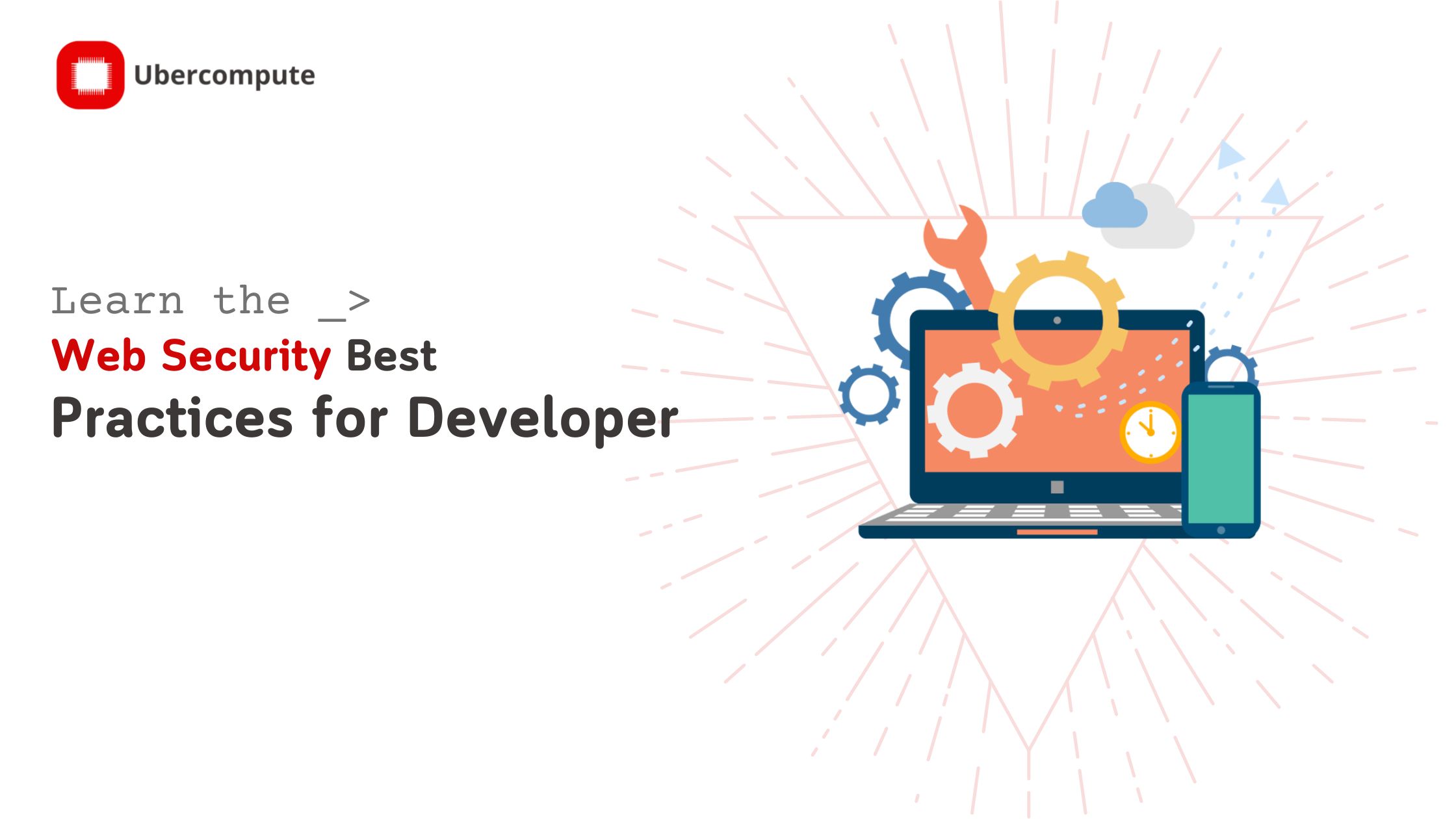As a developer, it’s important to prioritize web security best practices in your projects. With the increasing amount of sensitive information being shared and stored online, it’s more important than ever to protect against cyber threats such as hacking, data breaches, and malware attacks.
In this blog post, we’ll cover some key web security best practices that developers should follow to keep their websites and applications secure.
Importance of web security for developers
Web security is crucial for developers for a number of reasons. Some of the main reasons why web security is important for developers include:
- Protecting sensitive user data: When users trust your website or application with their personal information, it’s important to ensure that their data is protected against cyber threats. This includes protecting against data breaches, where hackers can access and steal sensitive user data.
- Maintaining user trust: If a security incident occurs on your website or application, it can damage the trust that users have in your company and discourage them from using your services in the future. By prioritizing web security, developers can help maintain user trust and build a positive reputation for their business.
- Protecting against legal liability: If a security incident occurs on your website or application, you could potentially face legal liability for failing to protect user data. By implementing strong web security measures, developers can reduce the risk of legal issues.
- Ensuring the overall security of the internet: Web security is not just about protecting individual websites and applications. It’s also about ensuring the overall security of the internet as a whole. By following best practices for web security, developers can contribute to the overall security of the internet and protect against cyber threats.
Overall, web security is important for developers because it helps protect sensitive user data, maintain user trust, reduce the risk of legal liability, and ensure the overall security of the internet.
Overview of common web security threats
There are many different types of cyber threats that can pose a risk to web security. Some common types of web security threats include:
- Malware: Malware is a type of software that is designed to damage or disrupt computer systems. This can include viruses, worms, and Trojan horses, which can spread from one computer to another and potentially cause serious damage.
- Phishing attacks: Phishing attacks are a type of scam where attackers try to trick users into giving away sensitive information, such as passwords or bank account numbers, by posing as a trustworthy entity. These attacks often take the form of fake emails or websites that look legitimate but are actually designed to steal user data.
- SQL injection attacks: SQL injection attacks are a type of cyber attack that targets databases by injecting malicious code into SQL statements. This can allow attackers to access sensitive data or even take control of a database.
- Cross-site scripting (XSS) attacks: Cross-site scripting attacks are a type of cyber attack that involves injecting malicious code into a website, which can then be executed by other users’ browsers. This can allow attackers to steal sensitive information or manipulate website content.
By understanding the common types of web security threats and taking steps to protect against them, developers can help keep their websites and applications secure.
Secure your web server and hosting environment
Your web server and hosting environment are crucial components of your website or application, and it’s important to secure them to protect against cyber threats. Here are some key best practices for securing your web server and hosting environment:
Regularly update and patch:
One of the most effective ways to protect your web server and hosting environment is to keep all of your software up-to-date with the latest patches and security updates. Hackers often exploit vulnerabilities in outdated software, so it’s important to make sure you’re using the most recent version. This includes your operating system, web server software, and any other software you use on your server or hosting environment.
Use secure protocols:
When transmitting sensitive data, such as passwords or credit card numbers, it’s important to use secure protocols to ensure that the data is protected against interception. HTTPS (Hypertext Transfer Protocol Secure) is a secure version of HTTP that encrypts data as it is transmitted between a web server and a client. By using HTTPS, you can help protect against man-in-the-middle attacks, where hackers can intercept and potentially steal sensitive data.
Implement firewalls and intrusion detection/prevention systems:
Firewalls and intrusion detection/prevention systems (IDPS) are security tools that can help protect your web server and hosting environment against cyber threats. Firewalls are designed to block unauthorized traffic to your server, while IDPS systems can monitor network traffic and alert you to potential security threats. These tools can help prevent cyber attacks and protect against data breaches.
By following these best practices, you can help secure your web server and hosting environment and protect against a wide range of cyber threats.
Secure your database and data storage
Your database and data storage systems contain sensitive information that needs to be protected against cyber threats. Here are some best practices for securing your database and data storage:
Use strong, unique passwords:
One of the most basic but important steps you can take to secure your database is to use strong, unique passwords for database access. This can help prevent unauthorized access to your database and protect against brute force attacks, where hackers try to guess weak passwords. It’s also a good idea to use different passwords for different databases or systems to reduce the risk of compromise.
Encrypt sensitive data at rest and in transit:
To further protect sensitive data, it’s important to encrypt it both at rest (when it is stored) and in transit (when it is being transmitted). This can help protect against data breaches and ensure that even if someone does gain unauthorized access to your database, they won’t be able to read the data.
Implement proper access controls and permissions:
Another way to secure your database and data storage is to implement proper access controls and permissions. This means setting up permissions for different users or groups of users and only allowing them access to the data they need. This can help prevent unauthorized access to sensitive data and reduce the risk of data breaches.
By following these best practices, you can help secure your database and data storage and protect against a wide range of cyber threats.
Secure your application code
Your application code is an essential part of your website or application, and it’s important to ensure that it is secure to protect against cyber threats. Here are some best practices for securing your application code:
Use input validation and sanitization:
One common type of cyber attack is an injection attack, where attackers try to inject malicious code into your application. To prevent this, it’s important to use input validation and sanitization to verify and clean user input before it is processed by your application. This can help prevent injection attacks and protect against a wide range of vulnerabilities.
Implement secure coding practices:
To further secure your application code, it’s important to follow best practices for secure coding. This can include avoiding hardcoded passwords, using prepared statements to prevent SQL injection attacks, and following secure coding guidelines for your programming language. By implementing secure coding practices, you can help protect against vulnerabilities and ensure the overall security of your application.
Use security testing tools:
Finally, it’s a good idea to use security testing tools to identify vulnerabilities in your application code. There are a wide range of tools available that can scan your code and identify potential vulnerabilities, such as SQL injection vulnerabilities or cross-site scripting vulnerabilities. By regularly testing your application code, you can help identify and fix any vulnerabilities before they can be exploited by attackers.
By following these best practices, you can help secure your application code and protect against a wide range of cyber threats.
Secure user accounts and authentication
User accounts and authentication are critical components of your website or application, and it’s important to ensure that they are secure to protect against cyber threats. Here are some best practices for securing user accounts and authentication:
Use strong, unique passwords and password hashing:
One of the most basic but important steps you can take to secure user accounts is to use strong, unique passwords. This can help prevent unauthorized access to accounts and protect against brute force attacks, where hackers try to guess weak passwords.
it’s also a good idea to use password hashing, which is a technique for storing passwords in a secure, encrypted format. This can help protect against password breaches and ensure that even if someone does gain access to your database, they won’t be able to read the passwords.
Implement multi-factor authentication:
Another way to secure user accounts is to implement multifactor authentication, which requires users to provide multiple forms of authentication before they can access their accounts. This can include something they know (such as a password), something they have (such as a security token), or something they are (such as a fingerprint).
By requiring multiple forms of authentication, you can greatly increase the security of user accounts and reduce the risk of unauthorized access.
Protect against brute force attacks:
Finally, it’s a good idea to protect against brute force attacks, which are attempts to guess weak passwords through repeated login attempts. To protect against these attacks, you can implement measures such as rate limiting (limiting the number of login attempts allowed per minute) or using CAPTCHAs to prevent automated login attempts. By implementing these measures, you can help prevent brute force attacks and secure user accounts.
By following these best practices, you can help secure user accounts and authentication and protect against a wide range of cyber threats.
Secure communications and data transfer
Ensuring the security of communications and data transfer is crucial to protect against cyber threats. Here are some best practices for securing communications and data transfer:
Use secure protocols (e.g. HTTPS) for transmitting sensitive data:
When transmitting sensitive data, such as passwords or credit card numbers, it’s important to use secure protocols to ensure that the data is protected against interception. HTTPS (Hypertext Transfer Protocol Secure) is a secure version of HTTP that encrypts data as it is transmitted between a web server and a client. By using HTTPS, you can help protect against man-in-the-middle attacks, where hackers can intercept and potentially steal sensitive data.
Implement transport layer security (TLS) for secure communication between servers:
Transport layer security (TLS) is a cryptographic protocol that provides secure communication between servers. It is commonly used to secure communication between web servers and clients, but it can also be used to secure communication between servers. By implementing TLS, you can help protect against man-in-the-middle attacks and ensure that sensitive data is secure as it is transmitted between servers.
Use secure file transfer protocols (SFTP, FTPS) for transferring files:
When transferring files, it’s important to use secure file transfer protocols to ensure that the data is protected against interception. SFTP (Secure File Transfer Protocol) and FTPS (FTP Secure) are two secure protocols that can be used to transfer files over a network. By using SFTP or FTPS, you can help protect against man-in-the-middle attacks and ensure the security of your file transfers.
By following these best practices, you can help secure communications and data transfer and protect against a wide range of cyber threats.
Conclusion
In this blog post, we’ve covered some key web security best practices that developers should follow to keep their websites and applications secure. These best practices include:
- Securing your web server and hosting environment by regularly updating and patching software, using secure protocols for transmitting sensitive data, and implementing firewalls and intrusion detection/prevention systems.
- Securing your database and data storage by using strong, unique passwords for database access, encrypting sensitive data at rest and in transit, and implementing proper access controls and permissions.
- Securing your application code by using input validation and sanitization to prevent injection attacks, implementing secure coding practices, and using security testing tools to identify vulnerabilities.
- Securing user accounts and authentication by using strong, unique passwords and password hashing, implementing multifactor authentication, and protecting against brute force attacks
- Securing communications and data transfer by using secure protocols for transmitting sensitive data, implementing transport layer security for secure communication between servers, and using secure file transfer protocols for transferring files.
By following these best web security practices, developers can help protect against a wide range of cyber threats and ensure the overall security of their websites and applications. It’s important to note that web security is an ongoing effort, and it’s important to stay up-to-date with the latest threats and best practices in order to keep your website or application secure.
In conclusion, web security is an important consideration for developers, and by following best practices, you can help protect against a wide range of cyber threats and ensure the overall security of your website or application.




